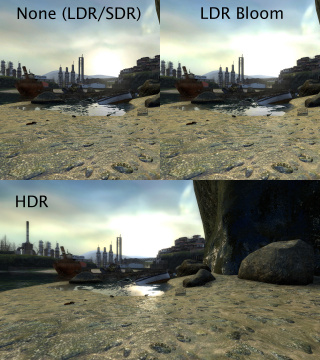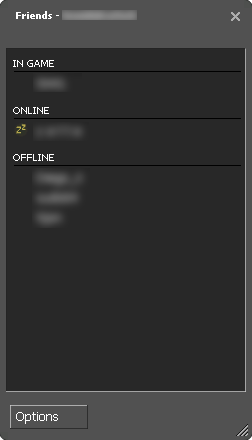Source 2006
(last engine & SDK Base update)
(2007, 2009/MP)

The ![]() Source 2006 engine branch, also known as the Episode One engine branch, and the last Old Engine branch, was first introduced in 2006 with
Source 2006 engine branch, also known as the Episode One engine branch, and the last Old Engine branch, was first introduced in 2006 with ![]() Half-Life 2: Episode One, with all previous games on
Half-Life 2: Episode One, with all previous games on ![]() Source 2004 (except Half-Life 2, Half-Life 2: Lost Coast, and Half-Life: Source) upgraded to this branch. Some features of Source 2006, such as HDR rendering and color correction, are first demonstrated in 2005 with
Source 2004 (except Half-Life 2, Half-Life 2: Lost Coast, and Half-Life: Source) upgraded to this branch. Some features of Source 2006, such as HDR rendering and color correction, are first demonstrated in 2005 with ![]() Half-Life 2: Lost Coast and
Half-Life 2: Lost Coast and ![]() Day of Defeat: Source (both of them runs on a updated version of Source 2004 when initially released).
Day of Defeat: Source (both of them runs on a updated version of Source 2004 when initially released).
Source 2006 (circa July 29, 2006) also introduces Source SDK Base (the 2006 version of SDK Base was later renamed to Source SDK Base 2006). Mod that are based on SDK Base instead of directly on Half-Life 2 will prevent incompatible engine updates (like Half-Life 2 upgraded to Source 2009 in 2010 on PC) from making the mod unusable.
It was distributed in base source engine 2.gcf. While it was succeeded by the Source 2007 (also known as Orange Box) branch, Source 2006 continued receiving engine updates until December 2009, and in 2010, all first-party Valve games (except ![]() and
and ![]() ) were upgraded to Source 2009. This branch requires
) were upgraded to Source 2009. This branch requires ![]() Half-Life 2 content to operate.
Half-Life 2 content to operate.
The engine versions for this branch are 2733 (EP1) up to 4044 (Protocol 7).[1]
The SDK and SDK Base game for this branch are free to all Steam users.
Features
Added
Previously introduced since ![]() Source 2004 (
Source 2004 (![]() /
/![]() engine update):
engine update):
- Anti-aliasing - MSAA up to 8x, and CSAA support.
- 8x MSAA can now be selected on the menu. Nvidia GPUs (from GeForce 8 up to Kepler-series / GeForce 600 & 700 card) can select CSAA anti-aliasing, which is less demanding than MSAA. CSAA is not supported on Maxwell GPUs (GeForce GTX 750, 750 Ti, 900 series) and later.
- Color correction
- Alter the color balance of an image to achieve a desired effect. For example, in
 Day of Defeat: Source, the color has been adjusted to be more desaturated.
Day of Defeat: Source, the color has been adjusted to be more desaturated. - Commentary System
- Allows DVD-like director's commentary to be embedded inside levels.
- Direct3D 9 - Shader Model 3 (DirectX 9.0+ feature level/
dxlevel 95) - Unlocks greatly improved shader performance.
- Patching levels with lump files - update entity lumps, changing a .BSP file's entities without recompiling the maps.
- Film grain post-processing effect
- Used in
 Day of Defeat: Source.
Day of Defeat: Source. - High Dynamic Range rendering (DX9 SM2)
- HDR rendering (also known as HDR lighting) simulates brightness values outside computer monitors' actual range, before downconverting to
 Standard Dynamic Range. This mainly involves "blooming" colors above 100% brightness into neighboring areas and adjusting a virtual camera aperture to compensate for any over-exposure that results. HDR rendering gives gives richer colors, better contrast and finer gradients. Not to be confused with HDR display output.
Standard Dynamic Range. This mainly involves "blooming" colors above 100% brightness into neighboring areas and adjusting a virtual camera aperture to compensate for any over-exposure that results. HDR rendering gives gives richer colors, better contrast and finer gradients. Not to be confused with HDR display output. - Originally introduced in
 Day of Defeat: Source and
Day of Defeat: Source and  Half-Life 2: Lost Coast (runs on newer version of Source 2004), but generally attributed to Source 2006.[2][3]
Half-Life 2: Lost Coast (runs on newer version of Source 2004), but generally attributed to Source 2006.[2][3]
New since ![]() Source 2004:
Source 2004:
- BSP version 20
- New BSP version, with new lumps.
- Detail prop shapes
- Improved detail sprites that sway in the breeze and bend away from nearby players.
- Dynamic interactions
- Dynamic interactions between NPCs using special animations.
- Facial animation upgrades
- More detail and intenser shapes for close-up performances.
- Improved prop_static lighting
- Static props without normal maps or phong can now be lit by VRAD per-vertex, instead of at runtime based upon their origin or $illumposition.
- Lightwarp textures (DX9+ SM3)
- 1D textures that tint a material per-texel depending on their brightness.
- Phong materials
- Diffuse reflections for skin and other roughened surfaces on models.
dxlevel 95 (DX9.0+ level) or later.Removed

- DirectX 6.0 (
dxlevel 60) compatibility level - Support for DirectX 6.x GPUs has been partially dropped, but is still usable.
- Steam Friends menu (and Friends v2)
- In-game friends list & instant messaging, allowing you to chat in-game without Alt + Tab ⇆ to Desktop and open Friends in Steam client. Source 2006 uses Friends v2 (formerly Friends Beta), which removes Parlor Games option (a feature which allows player to play Checkers, Chess, Go, Hearts and Spades with friends), and relies on Steam API instead of Steam TrackerNote servers which has been shutdown.
- Originally present before it was eventually removed in August 2007 engine update for Source 2006 (build date July 31, 2007), as many of it's functionality are replaced by Steam Overlay which is introduced with the launch of Steam Community, and the Steam update on the same day (August 6, 2007).[4] As of 2025, the friends feature (still works with latest Steam client) only works on Source 2004 games since 2006 (when Friends Beta was introduced), and all Source 2006 games before the "Friends" feature being removed. It can send messages to friends (the message is shown on Steam client, but not in-game). The Friends feature on older build of Source 2004 and GoldSrc (both from 2005 or earlier) no longer works, since the old Tracker server was offline.
Availability
Game code for the 2006 branch is included in the now-deprecated Source SDK app. To compile the code for 2006 branch, see Compiling under VS2005.
All Valve games introduced with Source 2006 and previous titles that are upgraded from ![]() Source 2004 to
Source 2004 to ![]() Source 2006 are now currently using Source 2013 Singleplayer or the Team Fortress 2 branch (previously Source 2013 Multiplayer).
Source 2006 are now currently using Source 2013 Singleplayer or the Team Fortress 2 branch (previously Source 2013 Multiplayer).
Usage
The following games still run on ![]() Source 2006:
Source 2006:
Valve
2006 Source SDK Base 2006
Source SDK Base 2006
Third-Party
Standalone
2006 The Ship: Murder Party and
The Ship: Murder Party and  The Ship: Single Player
The Ship: Single Player2006 Dark Messiah of Might and Magic
Dark Messiah of Might and Magic2007 Fortress Forever
Fortress Forever
- Available in two versions, original (on Source 2006) and upcoming Source 2013 Multiplayer version. Formerly SDK Base mod, now standalone.
2009 NEOTOKYO°
NEOTOKYO°
- Formerly SDK Base mod, now standalone.
2010 Vindictus
Vindictus
- Heavily modified, and uses proprietary file format to store game files. Also support Direct3D (DirectX) 11,
 Nvidia PhysX, 64-bit.
Nvidia PhysX, 64-bit.
- Heavily modified, and uses proprietary file format to store game files. Also support Direct3D (DirectX) 11,
SDK Base Mod
Known issues
dxlevel 81 or lower, only dxlevel 90 or higher.
Additionally, using any D3D9 wrapper (which translates to D3D11, D3D12 or Vulkan), like ![]() dgVoodoo 2 (even on systems with newer NVIDIA drivers that fixes this issue) on this branch, can also cause this issue.
dgVoodoo 2 (even on systems with newer NVIDIA drivers that fixes this issue) on this branch, can also cause this issue.
cl_showfps or cl_showpos 1, will be either cut off or completely hidden. (tested in: GMOD 9, HL2 old engine)System Requirements
Minimum Specs :
- OS: Windows 98 / ME, 2000, XP or later
- CPU: 1.2 GHz
- RAM: 256 MB
- Nvidia GeForce FX 5700, ATI Radeon 9500 (with 128MB VRAM)
- Direct3D 9.0 compatible video card (with atleast DirectX 7.0 compatibility level or higher)
References
| References | ||||||||||
|---|---|---|---|---|---|---|---|---|---|---|
|
